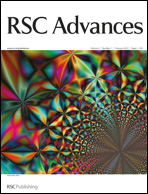The solubility of RE2O3 (RE = Eu, Sm, and Yb) with variable valence in molten salts is extremely low. It is impossible to directly obtain variable valence metals or alloys from RE2O3 using electrolysis in molten salts. We describe a new approach for the preparation of variable valence rare earth alloys from nano rare earth oxide. The excellent dispersion of nano–Eu2O3 in LiCl–KCl melts was clearly observed using a luminescent feature of Eu3+ as a probe. The ratio of solubility of nano-Sm2O3/common Sm2O3 is 16.98. Electrochemical behavior of RE2O3 on a molybdenum and Al electrode in LiCl–KCl melts containing AlCl3 at 480 °C was investigated by different electrochemical techniques, such as cyclic voltammetry (CV), square wave voltammetry, and chronopotentiometry. Prior to the reduction peak of Al, the reduction peaks of Sm(III)/Sm(II), Yb(III)/Yb(II), and Eu(III)/Eu(II) were observed at about −0.85, −0.45, and 0.39 V in square wave voltammetry, respectively. The underpotential deposition of RE on pre-deposited aluminum leads to the formation of Al–RE alloy. The structure, morphology, and energy dispersion analysis of the deposit obtained by potentiostatic electrolysis are analyzed. Al2Sm and Al3Sm alloys were successfully obtained from nano–Sm2O3.

You have access to this article
 Please wait while we load your content...
Something went wrong. Try again?
Please wait while we load your content...
Something went wrong. Try again?


 Please wait while we load your content...
Please wait while we load your content...